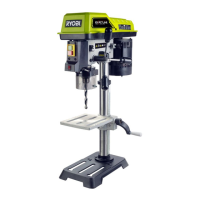16
NOTE: A bevel scale has been included to measure
approximate bevel angles. If precision is necessary, a
square or other measuring tool should be used to position
the table. To use the bevel scale:
1. Tighten the nut on the locking pin using a 10 mm or
adjustable wrench clockwise to release the pin from
its table support. This pin will be needed when placing
the table back to its 0 degree setting from the table
support. Do not throw away.
2. Loosen the large hex head table bevel locking bolt
using a 17 mm or adjustable wrench.
3. Tilt the table, aligning the desired angle measurement
to the zero line opposite the scale.
4. Tighten the table bevel locking bolt.
5. To return the table to its original position, loosen the
cable bevel locking bolt. Return the table to the 0°
position.
6. Return nut on locking pin to the outside end of threads.
Gently tap locking pin, using a rubber mallet, until it is
seated in the mating hole of the table bracket. Hand
tighten nut.
NOTE: The table has been removed from the
illustration for clarity.
WARNING
To prevent personal injury, always disconnect the plug
from the power source when making any adjustments.
SPINDLE / QUILL
See Figure 20.
Rotate the feed handles counterclockwise to lower spindle
to its lowest position. Hold the chuck and move it front to
back. If there is excessive play, proceed with the following
adjustments:
1. Loosen the lock nut located on the right side of the drill
press, using a 10 mm wrench.
2. Turn the screw clockwise to eliminate the play, using a
slotted screwdriver, but without obstructing the upward
movement of the spindle. (A little play in the spindle
is normal.)
3. Tighten the lock nut.
QUILL RETURN SPRING
See Figure 21.
The quill return spring may need adjustment if the quill
return speed is too rapid or too slow. This spring is located
on the left side of the drill head.
1. Lower the table for additional clearance.
2. Place a screwdriver in the lower front notch of the
spring cap. Hold it in place while loosening and
removing only the outer jam nut, using a 10 mm
wrench.
3. With the screwdriver still engaged in the notch, loosen
the inner nut just until the notch disengages from the
boss on the drill press head.
NOTE: Do not remove this inner nut, because the
spring will forcibly unwind.
4. Carefully turn the spring cap counterclockwise with the
screwdriver, engaging the next notch.
5. Lower the quill to the lowest position by rotating the
feed handle in a counterclockwise direction while
holding the spring cap in position.
6. If the quill moves up and down as you desire, tighten
the inner nut sung against the spring cap and spring
cap with the wrench. If too loose, repeat steps 3
through 5 to tighten. If too tight, reverse steps 4 and 5.
7. Secure the outer nut against the inner nut with the
wrench.
NOTE: Do not overtighten and restrict quill movement.
BELT TENSION
See Figure 22.
1. Open the pulley cover.
2. To unlock the belt tension, turn the belt tension
lock knob on the right side of the drill press head
counterclockwise.
3. Pull the motor toward the front of the drill press to
loosen the belt tension.
4. Position the belt on the correct pulley steps for the
desired speed.
5. Push the motor away from the drill press head until the
belt is properly tensioned.
NOTE: Belt tension is correct if the belt deflects
approximately 13 mm (1/2") when pressed at its
centre.
6. Tighten the belt tension lock knob to secure the motor
in position. Close pulley cover.
CHECKING/ADJUSTING LASER ALIGNMENT
Your tool is equipped with Laser Trac ®.
The laser beams will enable you to preview the drill bit
path on the workpiece to be drilled before you begin your
operation.
WARNING
Avoid direct eye contact
A laser light is radiated when the laser guide is turned
on. Avoid direct eye contact. Always unplug the drill
press from the power source before making any
adjustments.
■ A laser pointer is not a toy and should not come into
hands of children. Misuse of this appliance can lead to
irreparable eye injuries.
■ Any adjustment to increase the laser power is
forbidden.
■ When using the laser pointer, do not point the laser
beam towards people and/or reflecting surfaces.
Even a laser beam of lower intensity may cause eye

